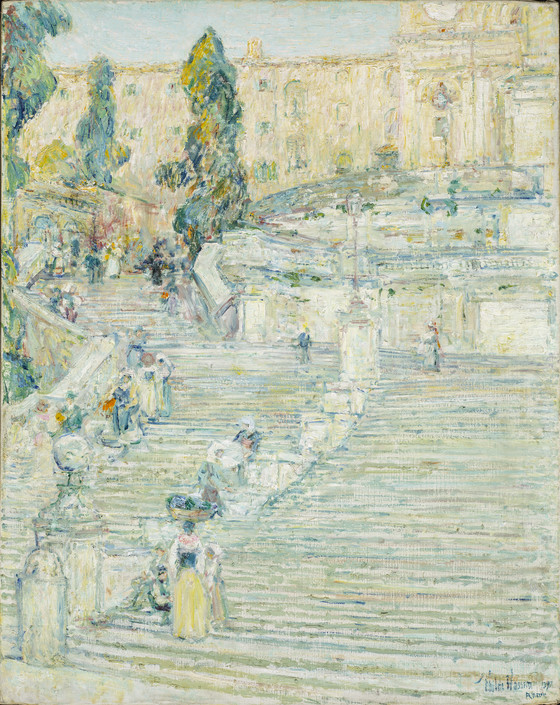The Spanish Stairs in Rome have been favored by tourists since they were constructed. The monumental double staircase with more than 130 steps was built in 1725 by the French on land owned by them....
The Spanish Stairs in Rome have been favored by tourists since they were constructed. The monumental double staircase with more than 130 steps was built in 1725 by the French on land owned by them. The stairs lead up a steep hill from a plaza to San Trinità dei Monti, which had been constructed earlier by Charles viii of France. Such throngs of people immediately flocked to see the stairs that guards from the nearby Spanish embassy were sent to keep order. While the French protested the Spanish intrusion onto their land, the Roman authorities ruled that the stairs fell under the jurisdiction of the Spanish. The public then began referring to the staircase as the Spanish Stairs.
Hassam, painted the stairs during his trip to Europe in 1896-98, when he spent the month of January 1897 in Rome. As so many Americans before him, Hassam became entranced by this scenic spot in the Holy City, and he is known to have painted it at least three times. A comparison of this version with the one in the Newark Museum, of the same size, reveals a change in the artist’s perception of the subject: in the museum’s version Hassam viewed the staircase as a tourist image, presenting an expansive view of the stairs and church above while in the Newark version he moved closer to the scene, thereby eliminating the church and the full sweep of the grand staircase.
In true impressionist fashion, Hassam may have used the motif of the Spanish Stairs to explore the effect of natural light during different times of the day. The Newark version has the brilliant color and intensity of a noonday sun, while the museum’s painting has a more delicate, opalescent palette, suggesting the faint light at the onset of twilight. The hues subtly change from the warm orange of the light of the setting sun caught by the top of the church in the upper right corner of the painting to cooler tones of blue and lavender proceeding down the stairs. The indistinctness of the figures also suggests the crepuscular light of late afternoon. Hassam exhibited a painting titled Le Soir Piazza de Spagna (Rome) at the 1897 Salon of the Société National des Beaux Arts, and the museum’s version, which has on its verso part of a French label dating from the 1890s, may be this evening scene.
More...



